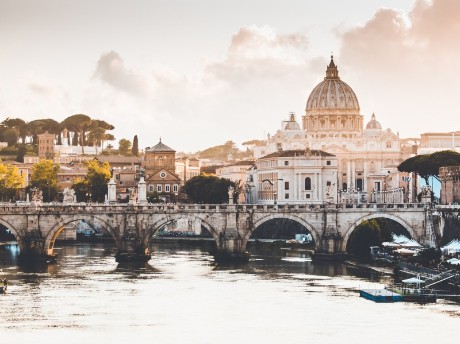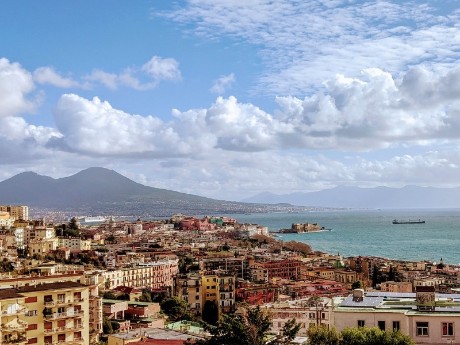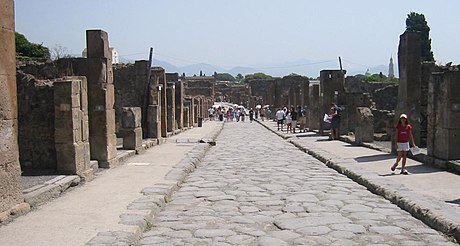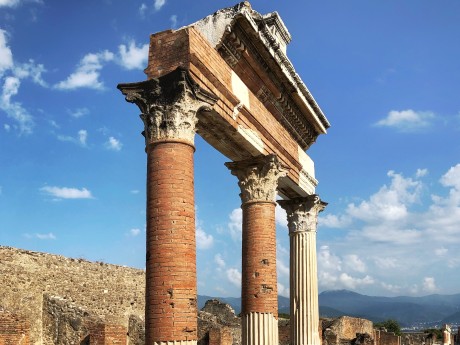Italy: Rome, Naples & Pompeii
Embark on a journey starting in iconic Rome and explore historic sites like the Pantheon and Trevi Fountain. In Naples, stroll the seafront or take a class on making Neapolitan pizza. In the ancient city of Pompeii, see where gladiatorial games were held at the famous Pompeii Amphitheatre. Marvel at Vatican City's views and visit St. Peter's Basilica, Vatican Museum, and Sistine Chapel.
Read more
Embark on a journey starting in iconic Rome and explore historic sites like the Pantheon and Trevi Fountain. In Naples, stroll the seafront or take a class on making Neapolitan pizza. In the ancient city of Pompeii, see where gladiatorial games were held at the famous Pompeii Amphitheatre. Marvel at Vatican City's views and visit St. Peter's Basilica, Vatican Museum, and Sistine Chapel. Visit the Royal Palace of Naples, a beautiful 17th-century palace that used to be the residence of the Bourbon Kings. Stroll through the vibrant Spaccanapoli, the main street of the historic centre. Explore the well-preserved ruins of the once-thriving city of Pompeii, and learn about life in ancient Roman times. Be sure to also visit the beautiful House of the Faun, which features stunning frescoes and mosaics. Enjoy world class cuisine, art, history, and beauty on this tour of culture and discovery. Waterviews strives to offer accommodation options within walking distance of water and/or in an area of touristic interest. Our prices include taxes (but excludes local tourist taxes). Customize your trip to your personal preferences with optional activities (hit the “Add Activities’’) or change hotels, etc. Contact us for customization at no extra cost at: Service@waterviewstravel.com
Destinations
- Rome
- Naples
- Pompeii
Itinerary
Rome

From the ancient walls of the Colosseum and the magic of the Trevi Fountain to the gilded churches of the Vatican City and the views from its seven hills, Rome is truly a dream. Stroll through the vibrant streets and you’ll get a taste for the city’s incredible past and rich culture, with ancient churches, Roman ruins and opulent fountains on every corner. And the city not only offers sightseeing - do as the locals and meander in piazzas, sample incredible street food and stop for an evening aperitivo to really experience la dolce vita.
Read more
From the ancient walls of the Colosseum and the magic of the Trevi Fountain to the gilded churches of the Vatican City and the views from its seven hills, Rome is truly a dream. Stroll through the vibrant streets and you’ll get a taste for the city’s incredible past and rich culture, with ancient churches, Roman ruins and opulent fountains on every corner. And the city not only offers sightseeing - do as the locals and meander in piazzas, sample incredible street food and stop for an evening aperitivo to really experience la dolce vita.
Additional Information
Situated on the River Tiber, between the Apennine Mountains and the Tyrrhenian Sea, the "Eternal City" was once the administrative centre of the mighty Roman Empire, governing a vast region that stretched all the way from Britain to Mesopotamia. Today it remains the seat of the Italian government and home to numerous ministerial offices. Rome has 2.7 million inhabitants while the metropolitan area is home to around 4.5 million.
Architecturally and culturally, Rome has some contrasts - you have areas with pompously huge majestic palaces, avenues and basilicas, which are then surrounded by tiny alleyways, little churches and old houses. The centre of Rome is mainly ancient, and modern buildings are usually concentrated in the suburbs, unlike Milan (where new and old architecture is combined both in the centre and the outskirts). You may also find yourself walking from a grand palace and tree-lined elegant boulevard, into a small and cramped Medieval-like street.
The abbreviation "S.P.Q.R" is ubiquitous in Rome, short for the old democratic motto "Senatus Populusque Romanus" (Latin), i.e. "The Roman Senate and People".
For two weeks in August, many of Rome's inhabitants shut up shop (literally) and go on their own vacations; many stores, restaurants and other amenities will be closed during this time. The temperature in the city centre at this time of year is not particularly pleasant. If you do travel to Rome at this time, be prepared to see Chiuso per ferie (Closed for holidays) signs on many establishments. Even in these weeks the city is very beautiful and if you are looking for a less overcrowded vacation in Rome, this is not a bad time. You will always be able to find somewhere to eat.
History
Rome's history spans over two and half thousand years, which have seen its transformation from a small Latin village to the centre of a vast empire, through the founding of Catholicism, and into the capital of today's Italy. Rome's history is long and complex. What follows is merely a quick summary.
Rome is traditionally thought to have been founded by the mythical twins Romulus and Remus, who were abandoned as infants in the Tiber River and raised by a mother wolf before being found by a shepherd who raised them as his own sons. Rome was founded as a small village sometime in the 8th century BC surrounding the Palatine Hill, including the area where the Roman Forum is found. Due to the village's position at a ford on the Tiber River, Rome became a crossroads of traffic and trade.
The settlement developed into the capital of the Roman Kingdom, led by a series of Etruscan kings, before becoming the seat of the Roman Republic at around 500 BC, and then the centre of the Roman Empire from 27 BC on. For almost a thousand years, Rome was the largest, wealthiest, most powerful city in the Western World, with dominance over most of Europe and the Mediterranean Sea. Even after the fall of the Roman Empire in the 5th century AD, Rome maintained considerable importance and wealth.
Beginning with the reign of Constantine I, the Bishop of Rome (later known as the Pope) gained political and religious importance, establishing Rome as the centre of the Catholic Church. During the Early Middle Ages, the city declined in population but gained a new importance as the capital of the newly formed Papal States. Throughout the Middle Ages, Rome was a major pilgrimage site and the focus of struggles between the Holy Roman Empire and the Papacy.
With the Italian Renaissance fully under way in the 15th century, Rome changed dramatically. Extravagant churches, bridges, and public spaces, including a new Saint Peter's Basilica and the Sistine Chapel, were constructed by the Papacy so that Rome would equal the grandeur of other Italian cities of the period. As the Grand Tour became customary for young European gentlemen in the 17th century, Rome became an important tourist destination, and remains as such until today.
In the 19th century, Rome again became the focus of a power struggle with the rise of the Kingdom of Italy, which wished to see a reunification of Italy. The Papal States remained in control of Rome under French protection, but with the outbreak of the Franco-Prussian War of 1870, French troops were forced to abandon Rome, leaving it clear for the Kingdom of Italy to capture. Rome became the capital of Italy, and has remained such ever since.
Rome today is a contemporary metropolis that reflects the many periods of its long history - Ancient times, Middle Ages, the Renaissance and the Modern Era. With the rise of Italian Fascism following World War I, Rome's population grew. This trend was stopped by World War II, which dealt relatively minor damage to Rome. With the dismantlement of the monarchy and the creation of the Italian Republic following WWII, Rome again began to grow in population and became a modern city. The city stands today as the capital of Italy and one of the world's major tourist destinations.
Climate
Rome has a Mediterranean climate, with hot, dry summers and mild, wet winters. In the winter months, daytime temperatures are usually pleasant and range from 10-15 °C, while nighttime temperatures tend to stay slightly above freezing. That being said, the occasional cold snap can cause temperatures to fall below freezing, and it is not unheard of for light flurries of snow to fall on occasion, though accumulation is rare, and major snowstorms are known to occur once every 20-25 years.
Background reading
At last count there were close to 1700 novels set in Rome in days gone by. Most easily available in bookshops are those by [http://lindseydavis.co.uk/ Lindsey Davis and Steven Saylor. Both are good storytellers and excellent at portraying life in Ancient Rome. Particularly interesting if you are visiting Rome may be Saylor’s Roma: The Novel of Ancient Rome, which traces the first thousand years or so of Rome’s history by following the fictional fortunes of two families. Each chapter begins with a map showing the state of Rome’s development at the time of the chapter.
The classic work on Ancient Rome remains Edward Gibbon’s History of the Decline and Fall of the Roman Empire. This was written in 1782 but is still being reprinted. A marvelous book that covers Rome’s fortunes from Romulus and Remus to the 1970s is Rome: The Biography of a City by Christopher Hibbert (Penguin). An excellent guide book, too, although perhaps a bit too heavy to carry around. Rome by Robert Hughes (Orion Books) concentrates on the city's art history and provides fascinating insights into the things you will see while walking around. SPQR, written by Cambridge University professor and British TV personality Mary Beard, and published in 2015, offers a detailed analysis of Rome's first 1000 years and attempts to answer why Rome expanded from a small village on the Tiber to the centre of a major empire.
English-language bookshops in Rome are: The Lion Bookshop, Via dei Greci, 36, close to Piazza di Spagna. Lots of books and a small cafe. Anglo-American Bookstore, Via delle Vite, 102, also close to Piazza di Spagna. A large store, with specialist sections. Strong on non-fiction. The Almost Corner Bookshop, Via del Moro 45, Trastevere. Small but very well-stocked store on the other side of the river. Some Italian bookstores also have English-language sections. Try the large selection of English books (but also French, Spanish and more) at Feltrinelli International in via Vittorio Emanuele Orlando - or the smaller selection at its store in Largo Argentina.
© Sourced from Wikivoyage
Naples

Naples is a dazzling blend of chaotic streets, grand architecture and world-renowned food, all with an incredible setting on the Mediterranean Sea overlooking Mount Vesuvius. A city of contrast, narrow streets are filled with rustic buildings strewn with clothes lines and a lavish Royal Palace sits alongside a magnificent 13th century cathedral, world-class museums and grand squares. Of course, the ancient city of Pompeii is a must see, and with arguably the best pizza in Italy visitors will have no shortage of culinary highlights to try.
Read more
Naples is a dazzling blend of chaotic streets, grand architecture and world-renowned food, all with an incredible setting on the Mediterranean Sea overlooking Mount Vesuvius. A city of contrast, narrow streets are filled with rustic buildings strewn with clothes lines and a lavish Royal Palace sits alongside a magnificent 13th century cathedral, world-class museums and grand squares. Of course, the ancient city of Pompeii is a must see, and with arguably the best pizza in Italy visitors will have no shortage of culinary highlights to try.
Additional Information
Naples represents one of the oldest continuously-inhabited cities in the world and a UNESCO World Heritage site with an unmatched heritage as a place of exchange between cultures. This is reflected in the city's structure and monuments, which are a mixture of Greek, Roman, Norman, Angevin, Spanish and French architecture. The UNESCO evaluation committee described Naples' historic centre – the largest in Europe – as being "of exceptional value", and went on to say that Naples' setting on its Bay "gives it an outstanding universal value which has had a profound influence". But Italians have known these things for centuries: The view of Naples from the sea is so beautiful that a traditional Italian saying states that once you've seen it, you can die.
As a testimony to its extraordinary history, the Naples region hosts an unparalleled concentration of UNESCO World Heritage sites: the Center of Naples itself; the Roman archaeological sites of Pompeii, Herculaneum, Cumae, Pozzuoli, Oplontis and Stabiae; the Royal Palace of Caserta; the royal site of San Leucio and the Aqueduct of Vanvitelli. It is close to Vesuvius, the only active volcano on the European continent and a UNESCO Biosphere Reserve. Paestum's Greek temples and the Amalfi Coast are possible day trips, as are the islands of Capri, Ischia and Procida in the Bay of Naples.
In literary history, Naples is known as a favorite destination of the Roman poet Virgil. This is where he wrote the Roman national epic "Aeneid", and where he was eventually buried. A more contemporary Neapolitan author is the pseudonym Elena Ferrante, whose Neapolitan Novels follow two girls growing up in a poor Naples neighborhood from the 1950s and onward.
Naples was the World Capital of Cultures in 2013, and it hosted the Universal Forum of Cultures (UFC) from April 10 to July 21, 2013.
History
The city was founded in 8th century BC as Parthenope, by Greek settlers from the nearby city of Cumae, itself founded by Greeks from the island of Evvia, in the area between Monte Echia and the island of Megaride, on a previous 2nd millennium BC settlement named Phaleros, a name connected to one of the Argonauts. The Cumaeans founded Neapolis ("New City") at the area of today's Piazza Municipio in 6th century BC, and the town became one of the most important Greek polis of Magna Grecia and the whole Mediterranean Sea.
In 320 BC, the city was conquered by the Romans, who let it maintain its Greek culture and language. With the fall of the Roman Empire, the town was conquered by the Byzantines, to became capital of an independent duchy.
Naples was later governed by Normans, Swabians and Angevins, who made it a capital; the King of Sicily became King of Naples after the Sicilian Vespers. During the first half of 17th century, Naples was one the main centers of the Spanish monarchy, and the most populated city in Europe, with more than 400,000 inhabitants.
After tragic events, like an eruption of Mount Vesuvius in 1630, the revolt of Masaniello in 1647 against the Spanish government, and the plague that killed half of the population in 1656, Naples reached a glorious period under the government of the House of Bourbon, that made it one of the most relevant cities in the continent about culture, economy and politics. Following the French and Napoleonic invasions, the Kingdom of the Two Sicilies was established in 1815, restoring the Bourbon dominance over Southern Italy and Sicily and making Naples the third most relevant city in Europe and the first one in present Italy for inhabitants and economy.
The annexation of the Two Sicilies to the newborn Kingdom of Italy in 1861 spelled, in fact, the beginning of a long period of decline for Naples and all Southern Italy. The town suffered the heavy bombings of World War II, that left deep scars in its monumental heritage, but succeeded in kicking out the German occupiers during the revolt known as "the four days of Naples".
Orientation
The Historical Centre, or Centro Storico of Naples is not only amazing but can also be something of a maze, filled with small irregular alleys. While the exact limits of the Centro Storico are a matter of debate, an inclusive definition could set its boundaries to Via Floria in the north, Corso Giuseppe Garibaldi to the east, the waterfront to the south and Via Toledo and the Quartieri Spagnoli to the west. Out of this huge area, the sections found to the north of Corso Umberto I, and to the west of Via Duomo are most likely to be of interest to travelers. While orientation in this area is difficult there are a few main roads by which you can direct yourself. Corso Umberto I cuts across the Centro Storico from the north-east to the south-west, connecting to the central train station in the north-east, and is one of few major multilane roads in historical centre. At Piazza Nicola Amore it crosses Via Duomo, a major road going across the centre from north to south. Finally, Via dei Tribunali and Spaccanapoli are two long, but rather narrow and crowded roads crossing the centre from east to west, both packed with street vendors and old churches. Notice that Spaccanapoli (literally "Naples splitter") is an unofficial name. The street's official names are Via Benedetto Croce for its western part and Via San Biagio Dei Librai for its eastern section. After crossing Via Duomo it loses much of its character, but continues east under the name Via Vicaria Vecchia.
South-west of the Centro Storico you will find the area San Ferdinando, consisting of a large headland into the bay of Naples. The area has long been the regal centre of Naples, with the two medieval castles Castel Nuovo and Castel dell'Ovo, and the old Royal Palace of Naples. Via Partenope and Via Nazario Sauro, packed with restaurants and hotels, follow the San Ferdinando waterfront and provide you with a beautiful view of the bay of Naples. Other areas of interest to tourists are Chiaia, an affluent district with plenty of opportunities for shopping directly west of San Ferdinando; and Vomero, a hilly residential area north of Chiaia and west of the Centro Storico, which due to its elevated location provide panoramic views of the bay and Vesuvius. Finally, aside from being beautiful, the bay to south of Naples and the mountain Vesuvius on its east are also good points of orientation, as they can be seen from several locations in the city.
Climate
Naples has Mediterranean climate, with cool, rainy winters, and hot, dry summers.
Snow is definitely rare, in fact the few snowfalls occurred are remembered as true events, in particular the one happened in February 1956. Despite this Naples has an annual average rainfall of 1007 mm, which is higher than that of Milan and London, also its rainfalls are usually concentrated in few days during the autumn (the city has 250 sunny days every year).
The prevailing wind is the libeccio, coming in from the sea in the south-west.
Tourist information
© Sourced from Wikivoyage
Pompeii

Pompeii is in Campania, Italy, not far from Naples. Its major attraction is the ruined ancient Roman city of the same name, which was engulfed by Mt. Vesuvius in AD 79. This is a UNESCO World Heritage Site.
Read more
Pompeii is in Campania, Italy, not far from Naples. Its major attraction is the ruined ancient Roman city of the same name, which was engulfed by Mt. Vesuvius in AD 79. This is a UNESCO World Heritage Site.
Additional Information
Romans took control of Pompeii around 200 BC. On August 24, 79 AD, Vesuvius erupted, burying the nearby town of Pompeii in ash and soot, killing 20,000 people, and preserving the city in its state from that fateful day. Pompeii is an excavation (It: scavi) site and outdoor museum of the ancient Roman settlement. This site is considered to be one of the few sites where an ancient city has been preserved in detail - everything from jars and tables to paintings and people was frozen in time, yielding, together with neighbouring Herculaneum which suffered the same fate, an unprecedented opportunity to see how the people lived two thousand years ago.
Tickets
One-day tickets are €15 per adult; €2 for EU citizens between 18 - 24 and school teachers; EU citizens below 18 get in for free (valid proving age document needed). A three-site pass (valid for 3 days) costs €18. This includes Oplontis and Boscoreale. The "Campania ArteCard", which costs €30 offers free admission to numerous sites in the region if you are planning to be in Campania for several days. The site is open daily from 8:30 to 19:30 (November to March from 8:30 to 17:00) and the last ticket is sold 90 minutes before closing. It is closed on 1st January, 1st May, and 25th December. Telephone: 081-857-5347.
Audioguides are available either at the train station InfoPoint or at the official entrance for €6,50, €10 for two, ID is required. They are not available at the secondary Eastern entrance by the Amphitheatre - which is the entrance nearest the modern day town centre if you are walking. Unofficial audio guides are on offer at one of the market stalls near this entrance. Take note that audioguide maps are not the same and the official audioguide comes with more audio points of interest. It's a good idea to check out both options before deciding. Pompeii may take several hours to explore so make sure to ask about the audioguide battery life before your purchase. Tour guides also cluster near the entrance and offer their services. It's a good idea to talk to one for a couple of minutes before deciding, to make sure you can understand their accent when they speak English. You can join a tour group with the train station InfoPoint for €12 (not including entrance fee) or €10 at the official entrance.
© Sourced from Wikivoyage





